J.H. Bordom,1 L. Billot,2 R. Gueguen3 and J.P. Deschamps2
المخططات الجديدة لنمو الأطفال دون سن المدرسة
جمال بردم، لوران بيو، رين قيقان، جون بير ديشون
الخلاصـة: أجري مسح مستعرض لأطفال المناطق الحضرية والريفية في إقليمين من أقاليم الجماهيرية العربية الليبية في الفتـرة من حزيران/يونيو 1999 إلى شباط/فبراير 2000، وذلك من أجل رسم منحنيات نمو جديدة للأطفال الليبيين الذين تقلّ أعمارهم عن خمس سنوات، ومن خلال استخدام منهجية منظمة الصحة العالمية لأخذ العينات العنقودية، تم انتقاء 1473 من الأطفال الذين تـتـراوح أعمارهم بين 0 و59 شهراً من الجنسين، وذلك من المناطق السكنية، ومراكز رعاية صحة الأمومة والطفولة، ودُوْر الحضانة وأقسام الولادة بالمستشفيات. ولقد أُنجز الرسم البياني والتسوية لمخططات النمو الخاصة بالوزن مقابل العمر، والطول مقابل العمر، والوزن مقابل الطول من أجل استخلاص المنحنيات المرجعية لاستخدامها في الأغراض السريرية، والوبائية، والبحثية. وعلاوة على ذلك فقد تم تحليل متوسط أحراز Z بالرجوع إلى المتغيرات الاجتماعية والديموغرافية التي جمعت من خلال اللقاءات التي أجريت مع الآباء. وتمثـَّلت العوامل الأكثر تأثيراً على أنماط نمو الأطفال في عمر الطفل، ومستوى تعليم الأم، وجنس الطفل.
ABSTRACT: To draw up new growth charts for Libyan children under 5 years of age, a cross-sectional survey was carried out in urban and rural areas in 2 regions of the Libyan Arab Jamahiriya from June 1999 to February 2000. Using WHO cluster sampling methodology, 1473 infants and children of both sexes aged between 0 and 59 months were selected from residential areas, maternal and child health centres, kindergartens and the delivery section of hospitals. Growth charts for weight-for-age, height-for-age and weight-for-height were plotted and smoothed, to provide reference curves for clinical, epidemiological and research purposes. In addition, mean Z-scores were analysed by sociodemographic variables collected from interviews with parents. Factors with a strong influence on childhood growth patterns were child’s age, mother’s education level and sex.
Nouvelles courbes de croissance pour les enfants libyens d’âge préscolaire
RÉSUMÉ: Afin d’établir de nouvelles courbes de croissance pour les enfants libyens de moins de 5 ans, une étude transversale a été réalisée en milieu urbain et rural dans deux régions de la Jamahiriya arabe libyenne de juin 1999 à février 2000. À l’aide de la méthode d’échantillonnage par grappes de l’OMS, on a identifié un échantillon de 1473 nourrissons et enfants des deux sexes âgés de 0 à 59 mois dans des zones résidentielles, des centres de santé maternelle et infantile, des écoles maternelles et des services de maternité d’établissements hospitaliers. On a tracé des courbes de croissance lissées poids-âge, taille-âge et poids-taille afin d’obtenir des courbes de référence à des fins cliniques, épidémiologiques et de recherche. De plus, les scores Z moyens ont été analysés en fonction des variables sociodémographiques recueillies lors d’un entretien avec les parents. Les facteurs ayant une forte influence sur la croissance étaient l’âge de l’enfant, le niveau d’instruction de la mère et le sexe.
1Department of Family and Community Medicine, Faculty of Medicine, University of Al-Jabel Al-Gharbi, Gharian, Libyan Arab Jamahiriya (Correspondence to J.H. Bordom:
This e-mail address is being protected from spambots. You need JavaScript enabled to view it
).
2Ecole de Santé Publique, Faculté de Médecine, Université Henri Poincaré, Vandoeuvre Les Nancy, France.
3Centre de Médicine Préventive, Vandoeuvre Les Nancy, France.
Received: 30/12/05; accepted: 12/07/06
EMHJ, 2008, 14(6):1400-1412
Introduction
Growth charts are simple tools for monitoring growth parameters and nutritional status in children. Regular assessment of growth patterns among preschool children is a major preventive tool to help detect underweight in individuals from low socioeconomic groups, and overweight or obesity among those of higher socioeconomic levels [1]. International growth charts allow comparisons between countries, but regional or national references are more useful in the assessment of local changes in nutritional status [2–4].
There are few studies concerning growth and nutritional assessment in the Libyan Arab Jamahiriya. However, 2 published investigations have been carried out in Tripoli. The first was a cross-sectional study of growth in urban preschool children [5] and the second was a set of anthropometric standards for Libyan children aged 6–17 years [6]. More recently, the nutritional status of preschool children was assessed as one of the objectives of the Arab Libyan Maternal and Child Health Survey (conducted by the Pan Arab Project for Child Development in 1995) [7]. Growth charts based on National Center for Health Statistics/World Health Organization (NCHS/WHO) data are still in use in Libyan maternal and child health centres [1].
The aim of this study was to draw up recent growth charts for Libyan children under 5 years of age and to analyse certain factors affecting the growth of preschool children. They are intended for use in assessing nutritional status, monitoring growth patterns and gathering data on physical parameters suitable for most clinical, epidemiological and research purposes.
Methods
Design and study area
A cross-sectional study was carried out in urban and rural areas in 2 regions of the Libyan Arab Jamahiriya (Tripoli and Al-Jabel Al-Gharbi) from June 1999 to February 2000, following World Health Organization (WHO) methodology [8]. Tripoli is the capital city and the largest and most densely populated city in the Libyan Arab Jamahiriya. There were 1 207 412 inhabitants in 1995 when the total population of the country was 4 389 739. As in most capital cities in the developing world, the population includes people who have migrated from every region of the country. Al-Jabel Al-Gharbi region is located 88 km south-west of Tripoli. It had 299 870 inhabitants in 1995. While Al-Jabel Al-Gharbi is more rural in character than the capital, the 2 regions include both urban and rural areas. In general, 76% of the Libyan population lives in urban areas [9] and, regarding basic needs, all regions of the Libyan Arab Jamahiriya are similar, with education and basic health care available free of charge throughout the country.
Sample
The initial sample comprised 1614 healthy infants and children aged 0–59 months who were free from chronic illness. Technical obstacles prevented our reaching the estimated sample of 1800 children (30 children from 60 communes).
A cluster random sampling technique using WHO methodology was used to recruit subjects [10]. First, we randomly selected 60 communes (clusters), i.e. 30 communes from each of the 2 regions. Then 30 children were selected from each cluster from residential areas, maternal and child health (MCH) centres, kindergartens or the delivery section of hospitals. The criteria for choosing the locations depended on the availability of a health establishment in the commune and the quality of services available.
Cluster sampling was used to recruit children from residential areas. Residential areas were the ideal places to select children from all age groups, even though we faced more obstacles when working in the community. After we selected the direction and starting point (the first family visited) in a commune, the sampling continued from door to door in each area to select 30 children from the commune.
Simple random sampling was used to obtain participants from MCH centres, kindergartens and the delivery section of obstetric hospitals. The location (MCH centre, kindergarten or hospital) depended on availability of these in each commune; in some areas 2 places were chosen according to the first step of selection of communes. The aim was to select a representative sample of 30 children from each location on the day of our visit. At visited MCH centres, 30 children were selected on vaccination days, at kindergartens 30 children were selected during our visit and at the delivery section of hospitals, 30 newborn infants (full-term, normal delivery) present on the day of the visit were selected.
Data collection
All children included in the study were subjected to the following:
Questionnaires
Interviews with parents were used to obtain general information about the influence on growth patterns of nutritional status and sociodemographic and cultural factors within the family. A questionnaire in Arabic was designed and pretested at the MCH centres and administered by the principal author and his team during the fieldwork. The questionnaire covered the educational and occupational status of the parents, family size, maternal age and area of residence (urban or rural). Data on age on the child were obtained from family register booklets or vaccination cards and recorded to the nearest completed month.
Anthropometric measurements
Anthropometric measurements (weight and height) were obtained according to standardized procedures [8]. Measurements were carried out in the child’s home, MCH centre, kindergarten or the obstetric hospital. Infants were weighed on an infant baby scale with a maximum capacity of 20 kg (graduated in 100 g). Children who weighed > 20 kg were weighed on personal Seca scales. Infants were weighed completely undressed, whereas older children wore minimal underwear. Weight was recorded to the nearest 0.1 kg.
For height, children < 2 years old were assessed for recumbent length to the nearest mm. Two examinations were made using a Seca-type baby length measure. One examiner held the child’s head and applied gentle pressure to bring the top of it into contact with the fixed headboard while another examiner extended the child’s legs and brought the movable footboard to rest firmly against the child’s heels with the toes in the right position. Children ≥ 2 years old were measured using an aluminium Seca-type vertical rule. The child stood barefoot with heels together and back straight, with his/her heels, buttocks, shoulders and head touching the device.
Statistical analysis
Statistical parameters included percentage and percentiles. Height and weight measurements were converted to Z-scores for comparison with the reference population [1]. Z-scores [11] were calculated as follows:
An analysis of variance (likelihood ratio test) was used to test for relationships between each Z-score and socioeconomic factors.
A total of 141 children were excluded from the analysis: 33 due to lack of data for birth lengths less than 49 cm in the NCHS/WHO reference population; 99 for birth weight < 2500 g; and 9 because one of their 3 Z-scores fell outside –6 and +6. The latter exclusion was as recommended in the literature [12]. The final analyses were done on 1473 of the original 1614 children. Curves for weight-for-age and height-for-age were smoothed with a 1-component model derived from the Jolicoeur, Pontier and Abidi (JPA-2) model [12]. The weight-for-height curves were smoothed with a linear regression. Growth charts were based on 3rd, 10th, 25th, 50th, 75th, 90th and 97th centiles.
Statistical analyses were done with SAS, version 8.1 [13].
Results
A total sample of 1473 infants and children of both sexes aged between 0 and 59 months were examined for weight and height. The main socioeconomic characteristics of the children are summarized in Table 1.
Weight-for-age
Figures 1 and 2 show the percentiles of weight-for-age distribution for both sexes. Table 2 presents the mean Z-scores for anthropometrics indices based on comparisons with the NCHS/WHO reference values, by selected sociodemographic characteristics of the studied sample. The mean Z-score of weight-for-age was higher in girls than in boys (P < 0.05). Mean weight-for-age Z-score decreased with increasing age (P < 0.001), and increased with the mother’s education level (P 0.05).
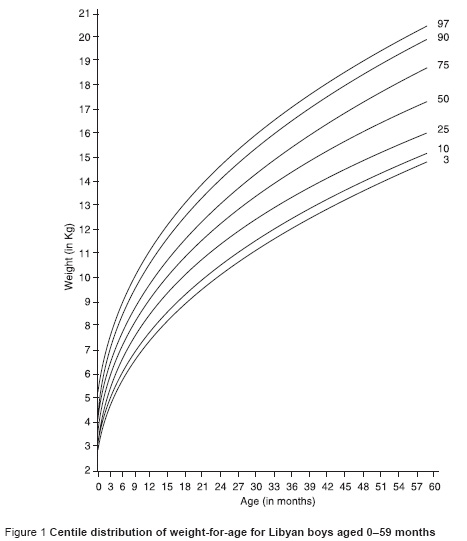
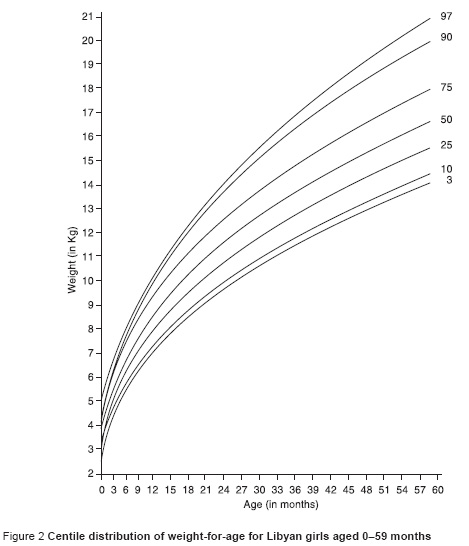
Height-for-age
Figures 3 and 4 show the percentiles of height-for-age distribution for both sexes. As Table 2 shows, there was no significant relationship between height-for-age Z-score and sex or area of residence (P > 0.05), but there was a highly significant relationship with age group in which mean height-for-age Z-score decreased as the child’s age increased (P < 0.001). In addition, mean height-for-age Z-score increased as mother’s education level increased (P < 0.05), and decreased with increasing family size (P 0.05).
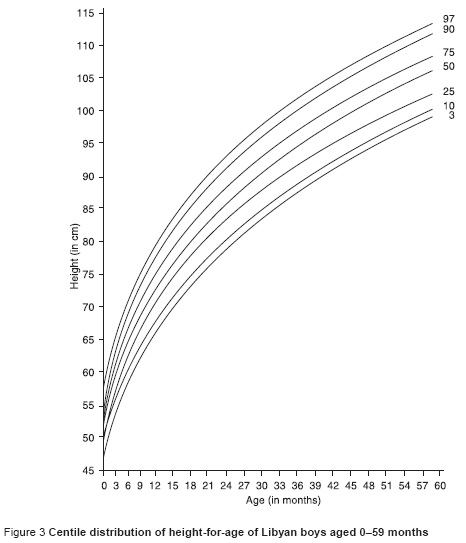
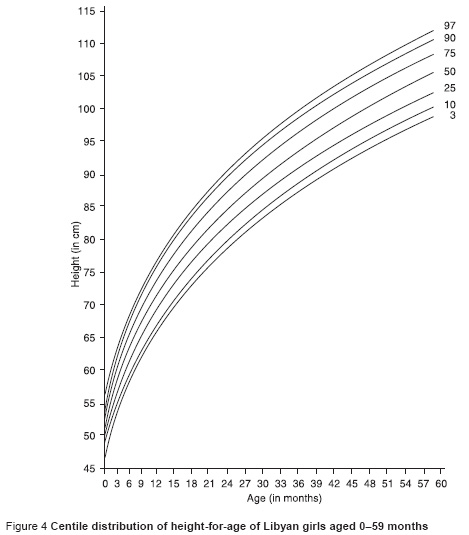
Weight-for-height
Figures 5 and 6 show the weight-for-height distribution for both sexes. The median (50th centile) values were higher in boys than in girls. As Table 2 shows, the weight-for-height Z-scores were highly significantly related to age group and maternal education (P < 0.001). The mean weight-for-height Z-score was higher for girls than for boys (P 0.05).
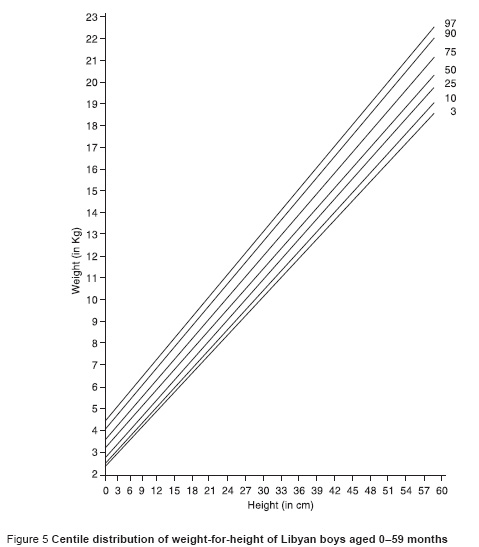
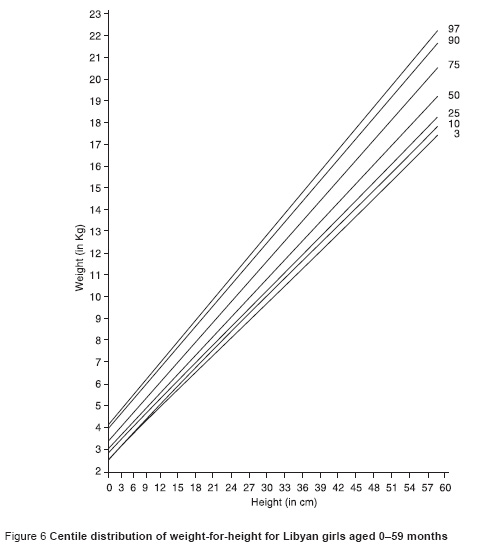
Discussion
The growth charts presented here are based on data collected in 2 regions of the Libyan Arab Jamahiriya from June 1999 to February 2000. They are representative of all socioeconomic groups, due to the sampling technique used in this study, and great care was taken during the fieldwork to ensure compliance with international methodological requirements. Measurements were taken by the same person (the principal author) using good quality equipment that was tested and calibrated at frequent intervals. The sample consisted of healthy members of both sexes. Although the sample was not as large as recommended by WHO, it was judged to be reasonable in view of the limited resources available for the study. The statistical models of Jolicoeur, Pontier and Abidi were applied to estimate percentile curves for infants and children aged from 0 to 59 months for all studied parameters [12]. The growth curves produced were based on data from breast- and mixed-fed children from various geographic and socioeconomic backgrounds.
Our study confirms that Libyan girls are heavier than boys, which might be due to the greater activity of boys than girls in and around the house. Interestingly, the results of the present study are in agreement with a previous study conducted in the Libyan Arab Jamahiriya [7,14].
Factors with a strong influence on childhood growth patterns in the present study were child’s age, mother’s education level and sex, mainly regarding wasting. Investigators from other countries also confirm the role of socioeconomic and demographic factors on stunting and wasting of children [14–16]. The existence of national and regional differences in growth patterns, mainly in the prevalence of stunting, is well described in the literature [14,16].
Mean Z-scores of the 3 indices (weight-for-age and height-for-age and weight-for-height) decreased as the child’s age increased; younger Libyan children were heavier than children of the NCHS/WHO reference population [1], whereas older children were lighter than the reference population. Mean Z-scores of the children of illiterate mothers were lower than those of other children and lower than the NCHS/WHO reference population. The Z-score values increased as the education level of mothers increased.
Other studies attributed the growth status of children to nutritional and environmental conditions, and socioeconomic and demographic factors; all of these are important factors that affect the growth pattern of children across different nationalities and across different areas within nations [15,16]. However, the nutritional state of Libyan children has improved during the last 2 decades as indicated by the results of this study and other studies conducted in the Libyan Arab Jamahiriya [7,14]. These changes may help to explain the improvement in growth and nutrition status among Libyan children. The higher immunization rate as indicated by the mother and child survey in 1995 [7], the higher mean duration of breastfeeding among Libyan mother (9 months) [17], the availability of higher energy foods, high female literacy and high gross national product are among the most important factors associated with lower prevalence of wasting and stunting among Libyan children [17,18].
In the Libyan Arab Jamahiriya, millions of Libyan dinars are being spent every year on health [18] and on subsidizing the principal foods. These foods account for a large proportion of the daily recommended allowances of carbohydrate and protein [19]. In general the nutritional status of Libyan children has improved as a result of the policy of development adopted throughout the country in recent decades. The lower prevalence of wasting, stunting and undernourishment appears to reflect improved nutritional and sociodemographic conditions in the country [17–19].
The present growth charts reported in our study differ from previous studies in 2 ways. Firstly, the data were drawn from 2 regions rather than 1 region as reported in 1979 [5]. Our study also represents groups from various socioeconomic categories, whereas the 1979 study was in urban preschool children from Tripoli. Secondly, our charts were fitted with the most recent mathematical models for weight-for-age, height-for-age and weight-for-height, whereas those produced in 1979 were hand-smoothed [5]. This smoothing has the advantage of making the curves more accurate and also allows for comparisons. Furthermore, a WHO report in 1977 recommended the use of Z-scores as statistical tests for easy comparison with other standards [11].
Comparisons with national and international references are necessary [8,15,20–22], although local references are preferable because of potential variations in the genetic or environmental factors that may affect the growth patterns of infants and children.
Conclusion
This study provides medical and paramedical staff with recent Libyan growth charts for weight-for-age, height-for-age and weight-for-height, as a reference for clinical, epidemiological and research purposes and as a screening tool to detect children at risk of health or nutritional disorders. Local growth charts are of particular value due to variations in environment or genetic factors that may affect the physical growth of children.
Acknowledgements
The authors would like to acknowledge Ms Monika Blossner for her kind response to our request and also for providing useful references. Thanks are due to all members of the Family and Community Medicine section at the Faculty of Medicine, Al-Fateh University, Tripoli, for their help and advice during the fieldwork.
References
- A growth chart for international use in maternal and child health care: guidelines for primary health care personnel. Geneva, World Health Organization, 1978.
- Habicht JP et al. Height and weight standards for preschool children. How relevant are ethnic differences in growth potential? Lancet, 1994, 1:611–5.
- Goldstein H, Tanner JM. Ecological considerations in the creation and the use of child growth standards. Lancet, 1980, 1:582–5.
- Eveleth PB, Tanner JM. Worldwide variation in human growth. Cambridge, Cambridge University Press, 1976.
- Tajouri RF. Cross-sectional study of growth in urban preschool children in Libya [PhD thesis]. University Children's Hospital, University of Zurich, Zurich, 1979.
- Abounaja SS. Anthropometric standards for Libyan children aged 6 to 17 years [PhD thesis]. Glasgow, Department of Statistics, University of Glasgow, 1986.
- Pan Arab Project for Child Development. Arab Libyan maternal and child health survey. Principal report, 1998. Tripoli, Libyan Arab Jamahiriya, General Committee for Health and Social Affairs, 1998.
- Measuring change in nutritional status. Guidelines for assessing the nutritional impact of supplementary feeding programme. Geneva, World Health Organization, 1983.
- Population census, 1995. Tripoli, Libyan Arab Jamahiriya, Information and Documentation Centre, 1995.
- Programme elargi de vaccination. Evaluer la couverture vaccinale. Genève, Organisation Mondiale de la Santé, 1984.
- Waterlow JL et al. The presentation and use of height and weight data for comparing the nutritional status of groups of children under the age of 10 years. Bulletin of the World Health Organization, 1977, 55:489–98.
- Jolicoeur P, Pontier J, Abidi H. Asymptotic models for the longitudinal growth of human stature. American journal of human biology, 1992, 4:461–8.
- SAS/STAT user’s guide, release 8.1. Cary, North Carolina, SAS Institute Inc., 1999–2000.
- Hameida J, Billot L, Deschamps JP. Growth of preschool children in the Libyan Arab Jamahiriya: regional and sociodemographic differences. Eastern Mediterranean health journal, 2002, 8(4/5):458–69.
- Frongillo EJ, de Onis M, Hanson KM. Socio-economic and demographic factors are associated with worldwide patterns of stunting and wasting of children. Journal of nutrition, 1997, 127:2302–9.
- Constant E. La croissance de l’enfant de la naissance à 4 ans : Nouvelles valeurs de reference persistence des ingalites socials [MD thesis]. Faculté de Médecine, Université Henri Poincaré, Vandoeuvre Les Nancy, France, 1993.
- Hameida J, Billot L. Nutrition status of Libyan children in 2000 compared with 1979. Eastern Mediterranean health journal, 2002, 8(2/3):261–71.
- Statistical bulletin. Tripoli, Libyan Arab Jamahiriya, Information and Documentation Centre, General Committee for Health and Social Affairs, 1994.
- Report of national supplies cooperation. Tripoli, Libyan Arab Jamahiriya, National Supplies Cooperation, 1999.
- Haschke F, van’t Hot MA. Euro-Growth references for length, weight, and body circumferences. Euro-Growth Study Group. Journal of pediatric gastroenterology and nutrition, 2000, 31(Suppl.1):S14–38.
- Centers for Disease Control and Prevention, National Center for Health Statistics. CDC growth charts: United States. Advance data no. 314, 2000 (revised).
- Al-Mazrou Y et al. Standardized national growth charts of 0–5 years old Saudi children. Journal of tropical pediatrics, 2000, 46:212–8.



